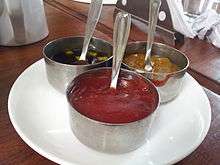Fry sauce
|
Fry sauce with fries | |
| Type | Sauce |
|---|---|
| Place of origin | United States |
| Region or state | Utah, Idaho |
| Created by | Don Carlos Edwards |
| Invented | 1941 |
| Serving temperature | At room temperature approx 20°C |
| Main ingredients | Ketchup, mayonnaise |
Fry sauce is a condiment often served with French fries or tostones (twice-fried plantain slices) in many places in the world. It is usually a combination of one part tomato ketchup and two parts mayonnaise.
In the United States

Fry sauce was originally popularized in the United States by a chef named Don Carlos Edwards, who served it in his first restaurant, Don Carlos’ Barbecue in Salt Lake City, which eventually became the Utah-based restaurant chain Arctic Circle in the 1950s.[1] The chain still serves fry sauce in its western United States restaurants.[2]
In Puerto Rico, mayoketchup is widely used with tostones and fried foods. It is made of two parts ketchup and one part mayonnaise with the addition of garlic.[3]
In April 2018, Heinz announced plans to release "mayochup", a pre-made mixture of mayonnaise and ketchup, if 500,000 users voted "yes" in a Twitter poll asking Americans if they wanted to see it in stores. A number of Twitter users responded that such a mixture already existed as "fry sauce" and "fancy sauce".[4][5] The sauce is set to arrive to U.S. shelves in late September 2018.
In May 2018, Fancy Sauce announced plans to release its "fancy sauce" condiment, a take on the traditional ketchup, mayo blend without actually combining ketchup and mayo.[6]
Outside the United States
In Argentina, Uruguay and Chile, a similar condiment known as salsa golf (golf sauce) is a popular dressing for fries, burgers, and steak sandwiches. According to tradition, the sauce was invented by Luis Federico Leloir, a Nobel laureate and restaurant patron, at a golf club in Mar del Plata, Argentina during the mid-1920s.[1][7]
In France, many Turkish restaurants and fast food establishments serve fry sauce and call it sauce cocktail; it is also common for customers to request ketchup-mayo (a dab of mayonnaise and a dab of ketchup) alongside their French fries at such places. Both sauce cocktail and the thousand island-like sauce cocktail can often be found in supermarkets.[8][9]
In Germany, a popular product called Rot Weiss (red white) is sold in toothpaste-style tubes; it consists of unmixed ketchup and mayonnaise, which form a red-and-white striped string when squeezed out. Fries at restaurants are sometimes served with an equal mixture of ketchup and mayonnaise.[10] Pommes-Soße or Frittensoße (fry sauce) is a lightly spiced mayonnaise similar to the Dutch Fritessaus. A condiment similar to the American fry sauce is known as Cocktailsoße, but it's more often used for döner kebab than for French fries.
In Belgium, a dash of whisky is often added to the sauce. It is popularly served with steamed shrimp and seafood on the half shell.
In Iceland, a condiment similar to fry sauce called Kokteilsósa (cocktail sauce) is popular.[11]
In Sweden, this variation is known as Rhode Island dressing [12]
See also
References
- 1 2 "A Brief History of Fry Sauce, Utah's Favorite Condiment". Eater. 2016-08-06. Retrieved 2017-04-08.
- ↑ Vergakis, Brock (January 6, 2007). "My oh my do we love fry sauce!". The Deseret News.
- ↑ "mayoketchup Puerto Rico". Retrieved 2016-08-21.
- ↑ McCluskey, Megan (13 April 2018). "Heinz' New 'Mayochup' Sauce Incites Total Condiment Mayhem". Time. Retrieved 13 April 2018.
- ↑ Olumhense, Ese (April 12, 2018). "Heinz Teased 'Mayochup', a New Mayo and Ketchup Condiment. A Contentious Online Debate Ensued". Chicago Tribune. Retrieved April 19, 2018.
- ↑ Cassar, Laura (4 May 2018). "Second Brome to open | Fancy Sauce to launch | Estia Greek Street Food expanding". Time. Retrieved 4 May 2018.
- ↑ Salsa golf at the Spanish Wikipedia
- ↑ "Bénédicta". Web.archive.org. Archived from the original on 2009-06-17. Retrieved 2016-08-04.
- ↑ "Bénédicta". Web.archive.org. Archived from the original on 2009-06-17. Retrieved 2016-08-04.
- ↑ Leao, Pedro Macedo (2011). Germany: Keys to Understanding German Business Culture. USA: Lulupress. p. 45. ISBN 978-1-4478-6295-6.
- ↑ "Forsíða | Síminn". Simnet.is. Retrieved 2016-04-30.
- ↑ "survivinglifeinsweden;". survivinglifeinsweden. Retrieved 2018-02-18.
Further reading
External links
| Wikimedia Commons has media related to Fry sauce. |
